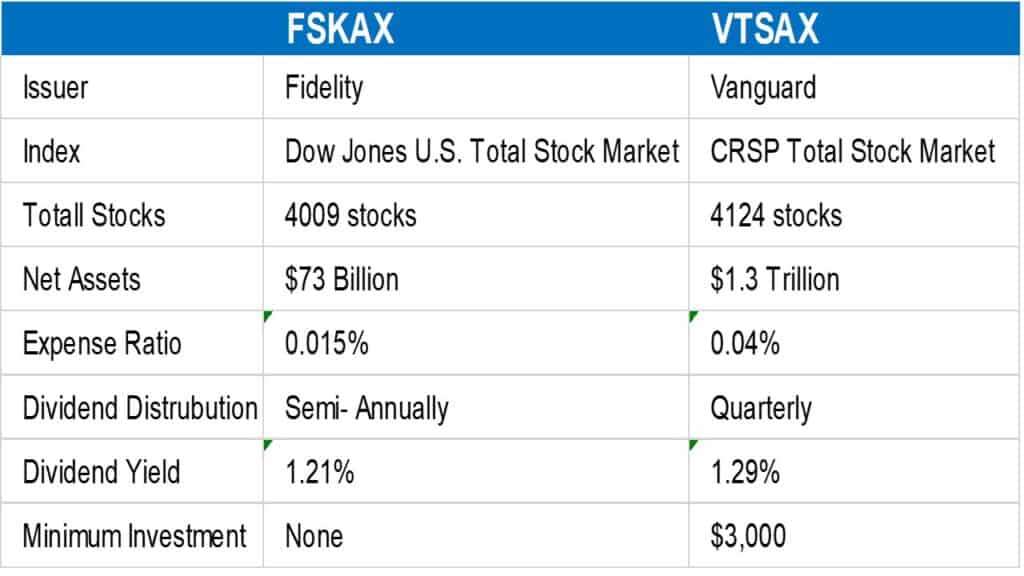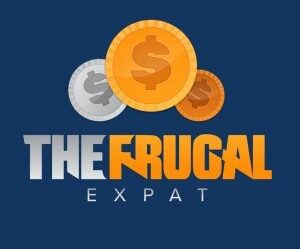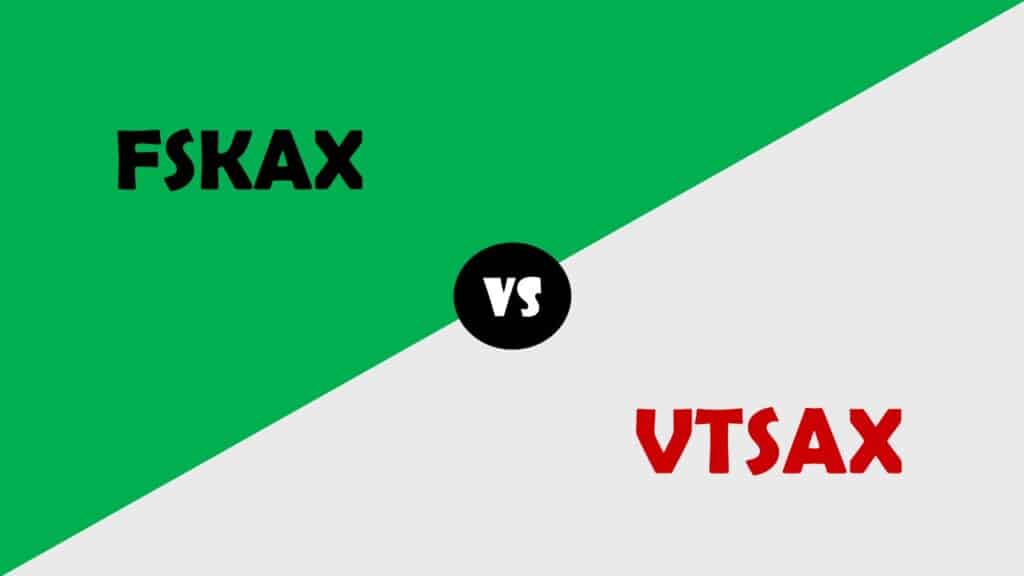In the battle over which index reigns supreme, two index funds fight over which is better, FSKAX vs VTSAX. Both FSKAX vs VTSAX are total market index funds with a broad range of stocks that bring about a low expense ratio.
As you build an investment portfolio, you will need to consider a few things. First of all, are the funds coming in with high fees? A fund with a higher fee can be night in a day to one that has low costs. The ARKK technology ETF has an expense ratio of 0.75%, which means the fund costs $75 for every $10,000 invested. If you have a fee of 0.04%, you save $71 for every $10,000 invested.
Looking at index investing for creating a passive portfolio is one way to create a simple path to create wealth. FSKAX vs VTSAX are prime examples of some of the best brokerage companies trying to win over customers with their top-of-the-line mutual funds.
Vanguard and Fidelity come head to head with some of the best index funds on the market. Schwab is right behind them, but we will focus on the Vanguard index funds vs Fidelity index funds.
What is a Total Market Index Fund?
A total market index fund is a mutual fund that tracks or mirrors the total market index. The index can be the CRSP index of the Dow Jones U.S. Total Market Index. These two indexes track the U.S. stock market.
Why would someone want to own the total market? One of the significant reasons is to have a piece of everything. Suppose you want to be invested in every company in the U.S. to have a balanced, diversified portfolio. In that case, it cannot be any easier than investing with a total market index fund.
FSKAX vs VTSAX are the top two options for investing in the total market index. They both have different fees, tax efficiency structures, dividend payout times, and track other indexes. So they are not the same, but you can go with the one you feel most comfortable with since they are pretty similar.
FSKAX: Fidelity Total Market Index Fund
FSKAX is the name of the Fidelity Total Market Index Fund, and it is the main competition for Vanguard’s VTSAX. Fidelity created FSKAX to give its customers a share of every stock on the U.S. market. It tracks the Dow Jones U.S. Total Stock Market Index.
FSKAX was created in 2011 and has grown to be one of the most significant index funds in the world. It currently holds 4009 different stocks with over $73.8 billion in assets.
It has an expense ratio of 0.015%. That means it costs $1.50 for every $10,000 invested.
Dividends are distributed twice a year. Once in April and the last dividend is given in December.
Unlike VTSAX, FSKAX does not have an initial investment minimum to start investing. You can start investing with $10, $5, or even $1.
Top 10 Holdings of FSKAX:
- Apple Inc.
- Microsoft Corp.
- Amazon.com Inc
- Tesla Inc.
- Alphabet Inc Class A.
- Alphabet Inc Class C
- Nvidia Corp.
- Berkshire Hathaway Inc.
- Meta Platforms Inc.
- UnitedHealth Group Inc.
These top 10 holdings for FSKAX make up about 24.64% of its overall portfolio. It has most of its money invested with large-cap stocks and a small percentage in small-cap stocks.
Over the last ten years, FSKAX has averaged 14.12% annually, making it a significant fund to hold in your brokerage or retirement accounts.
VTSAX: Vanguard Total Stock Market Index Fund
VTSAX stands for Vanguard Total Stock Market Index Fund Admiral Shares. The fund was created in 1992 by the Vanguard group to track the CRSP Total Market index. It has grown in popularity with much of the FIRE movement, especially since it created the popular exchange-traded fund (ETF) VTI. VTI and VTSAX are similar in the fund composition but differ as the ETF is traded like a stock.
If you are looking at purchasing VTI, you could find it almost anywhere, but M1 Finance is a great place to pick up shares and create a great portfolio.
VTSAX comprises 4124 stocks with net assets of $1.3 Trillion. The expense ratio is slightly higher than FSKAX, but the expense ratio is 0.04%. If you were to invest with VTI, the expense ratio would be 0.03%.
VTSAX is a well-diversified index fund. It is slightly skewed towards the tech industry, making up about 27% of the assets in its portfolio, but the tech companies do control such a large market cap on the U.S. market.
VTSAX does have a minimum investment of $3,000. Unlike FSKAX, VTSAX is more tax-efficient and will distribute dividends quarterly as in March, June, September, and December.
The Top 10 Holdings in VTSAX:
- Apple Inc.
- Microsoft Corp.
- Alphabet Inc.
- Amazon.com Inc
- Tesla Inc.
- Nvidia Corp.
- Berkshire Hathaway Inc.
- Meta Platforms Inc.
- UnitedHealth Group Inc.
- Johnson & Johnson
The top 10 holdings for VTSAX make up about 25.6% of the entire portfolio. The fund has a significant portion in large-cap stocks, which can be similar to funds that track the S&P 500.
Over the last ten years, VTSAX has had an average return of 14.24% annually, making it a significant fund to add to a retirement account like an IRA or Roth IRA.
FSKAX vs VTSAX: Similarities
FSKAX and VTSAX are almost identical. They have a similar amount of stocks that they have under management. Their performances are comparable (VTSAX has had better performance over the last ten years). Their expense ratios are some of the lowest (FSKAX is cheaper).
Both of these funds are managed passively. They are not in a competition to try to beat the market. They want to mirror and do the same as the market. It is hard to beat those index funds.
FSKAX vs VTSAX: Key Differences:
There are some key differences to consider as we compare these two total market stock index funds. VTSAX mirrors the CRSP Total Market Index, and FSKAX mirrors the Dow Jones U.S. Total Market Index. They are not identical.
Besides those two things, there are differences in fees, tax efficiency, and dividend distribution.
FSKAX vs VTSAX: Fees
Both of these funds are low-cost index funds meant to be passive investments. Each one has some of the lowest fees on the market. FSKAX has an expense ratio of 0.015%, and VTSAX has an expense ratio of 0.04%.
The expense ratio is an underlying cost of doing business. No managers are being paid to constantly buy and sell to beat the market; these are just fees to help keep the lights on.
As you can tell, FSKAX has a lower fee. If you had an extensive portfolio of $1 million, the expense ratio of FSKAX would be a difference of 0.025%.
It is not the biggest deal, but it depends on your value.
FSKAX vs VTSAX: Tax Efficiency
Taking a look at the tax efficiency of each fund, you will find that both funds are pretty tax-efficient overall. If you want to have the most tax efficiency, it would be best to go with an ETF. Instead of selling shares that incur capital gains, ETFs will give their share in kind to different authorized users for a cash value, making it more tax efficient.
Looking at the numbers for ten years, VTSAX loses 0.49% annually from taxes. FSKAX will lose 0.52% from taxes annually.
At this moment, you can tell that VTSAX is saving about 0.03% in taxes annually and adding that to the performance gains over a long period.
FSKAX vs VTSAX: Dividend Distribution
Each of these funds pays dividends throughout the year. FSKAX pays dividends twice a year in April and December, and VTSAX has dividends paid quarterly. Dividends being paid throughout the year or semi-annually have not affected the overall performance of these two funds.
If you would like to have your dividends come in more regularly, then VTSAX will give them at least four times a year.
FSKAX vs VTSAX: Which is Better?
Total stock market index funds are great investments for you to build wealth. FSKAX and VTSAX are two of the best options to invest in for having a piece of every stock on the stock market. You cannot go wrong with investing in either of these. They are both winners in their light.
If you are looking for a low minimum to start investing or a low expense ratio, choose FSKAX. It will allow you to start investing with little money, and it will help you begin your new journey into creating wealth.
If you are looking at a tax-efficient fund with better performance and has been around the longest, choose VTSAX. The only issue is the $3,000 minimum to invest in this index fund. Go with its little brother, the ETF VTI if that is the issue. That will allow you to start investing with any brokerage company as soon as possible.

FSKAX vs VTSAX: Which Should I Choose?
Vanguard and Fidelity are two of the best brokerage companies out there. They are different and provide excellent quality products. The choice is yours on what you choose.
The Johnson family owns Fidelity. Their intentions could be about them making money, but that is just an assumption. The investors of their funds own the Vanguard Group, so the managers are looking at returning great value to their investors.
Either way, you cannot go wrong choosing one over another. The choice is yours, and you will make a good choice by selecting one of these significant index funds.
Final Thoughts:
As you are looking to invest in index funds, FSKAX and VTSAX are two of the best passively managed mutual funds. They are not seeking to outperform the market but to mirror it.
These two funds are very similar in their makeup as they both work at passive investing over having an actively managed portfolio. You cannot go wrong with either of these funds if you are looking for lower fees, but FSKAX wins in the lower fees category. VTSAX wins in performance and tax efficiency.
The choice is hard. You cannot go wrong with either of these during times of volatility. Just take a buy-and-hold approach and pick one.
Related Reads:
- VTSAX vs FZROX: Who is The Best?
- VTSAX vs VFIAX: Which One Would You Choose?
- SPY vs VOO: Which S&P 500 ETF is The Better Buy?
- VOO vs VTI, Which One Would You Choose?

I’m Steve. I’m an English Teacher, traveler, and an avid outdoorsman. If you’d like to comment, ask a question, or simply say hi, leave me a message here, on Twitter (@thefrugalexpat1). Many of my posts have been written to help those in their journey to financial independence. I am on my journey, and as I learn more I hope to share more. And as always, thanks for reading The Frugal Expat.







